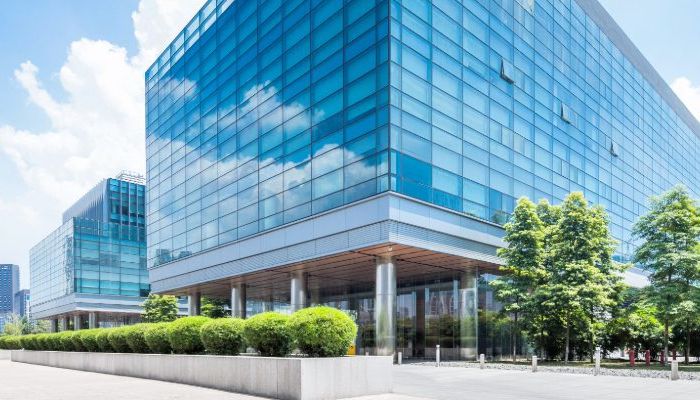COVID-19 vaccinations are starting to bring us closer to the time when businesses can invite employees safely back to the office. Over the past few months, we’ve seen many headlines with large employers announcing plans to embrace a hybrid workplace model in the post-pandemic world. This is a transformation strategy that should be considered by businesses of all sizes, because it creates an opportunity to optimize both real estate and employee experience.
Recently, FM:Systems and JLL presented a webinar about how to prepare for the hybrid workplace. We’ll cover highlights here, but for a more comprehensive examination of the hybrid workplace model, watch the webinar.
Business trends and executive beliefs are changing
According to research by JLL and McKinsey, the future of work is hybrid as employers shift toward a more worker-centric model. Further, employees have reexamined and reprioritized what matters most to them during the pandemic. A recent JLL survey of office workers showed 66% of employees favor a hybrid workplace and the majority would prefer to continue working from home some of the time after the pandemic ends.
Simply put, there’s a new model for the workplace emerging and it will be driven by employee experience and enabled by technology. Productivity stats reveal that remote workers can be as productive or more productive than onsite workers, if organizations pursue the right engagement and technology strategies. PWC recently surveyed CEOs about post-pandemic workforce plans and discovered that 61% intend to keep low-density workplaces after the pandemic. Additionally, a Gartner survey indicated that 82% of leaders plan to continue allowing remote work at least part of the time.
What is the hybrid workplace model?
Companies adopting a hybrid workplace model will offer employees the flexibility needed to ensure well-being and the productive workspaces required to drive innovation and collaboration. Each company will approach its hybrid model a bit differently—tailoring it to meet the unique needs of the organization. Every business will need to figure out exactly what the hybrid model will mean in each of these four dimensions:
- Business: What does hybrid work mean to the organization and how will it be performed?
- People: The hybrid workforce will need more flexibility and will need technological support for working onsite or remotely.
- Workplace: The hybrid workplace will be a place for collaboration and teamwork, as well as a driver of company culture.
- Real estate: The portfolio will need to be adjusted to operational the hybrid model.
Organizations implementing a hybrid work model will still have offices, though the number, locations and layouts for those may change. Some employees will choose to work full-time at the office. Others will have roles that require it. Some employees will work from home all or most of the time. In most cases, the bulk of employees will split their time between being in the office collaborating with others and working from home on individual tasks.
Benefits of the hybrid workplace
During the webinar, JLL Digital CIO, Eddy Wagoner, explained that a lot of executives he’s talked to have never considered the role real estate can play as a transformation opportunity. But across many industries, the shift to a hybrid work model will part of the ongoing digital transformation of business. There will be a number of benefits for organizations willing to adopt a hybrid work model:
- Increased recruiting success as workers who value flexibility navigate to businesses that support remote work.
- Better employee satisfaction and retention.
- Optimization of the real estate portfolio, reducing lease and operating costs.
- Improved sustainability as a smaller commercial real estate footprint reduces energy consumption and greenhouse gases.
- Workspace elasticity, or the ability to use space for different activities based on needs.
- Greater organizational resiliency in the future.
Who should be involved in transition planning for a hybrid workplace?
Too often, companies don’t bring all of the key stakeholders together when planning for the hybrid workplace. But this transition is too important not to look at it from every angle. It’s important to break down silos and obtain a holistic view from a cross-functional team.
If your organization has transformation executives whose job it is to look for opportunities to achieve long-term strategic advantage, give them a leading voice in the hybrid workplace conversation. The other groups that should be involved include:
- The executive team, to provide leadership about long-term objectives.
- Human Resources, which is responsible for employee experience and engagement. They also need to be part of conversations about employee safety when returning people to the office.
- Facilities Management and Real Estate have critical data about occupancy and floor plans that will be needed to rearrange and workspace for safety, reimagine it for hybrid work, and make portfolio optimization decisions.
- The IT department needs to support the hybrid model, where employees will need access to reliable technology that works well in the office and at home.
- As ideas start becoming plans, both Operations and Finance may need to be involved.
Technology supports the transition to a hybrid workplace model
To successfully transition to a hybrid work model, organizations will need to leverage Digital Workplace Management solutions and the real-time utilization, occupancy, environmental, and cost data they can provide. This data provides the foundation for planning a safe return to the office and a better, more flexible employee experience in the future.
FM:Systems customers already have access to this data and the analytical tools needed to analyze it. Our solutions have provided customers with a strong management and planning advantage both during the pandemic and today, as you plan for the hybrid workplace. Tools and functionality—from visualizations to dashboards to analytics—found within FM:Systems software will provide the information needed to start conversations, generate new ideas, drive key decisions, and develop transformation plans.
Learn more about how innovative technology will drive workplace transformation. Watch the webinar for the complete conversation between Michael Gresty, VP of Strategy of FM: Systems and Eddy Wagoner, Digital CIO of JLL.










